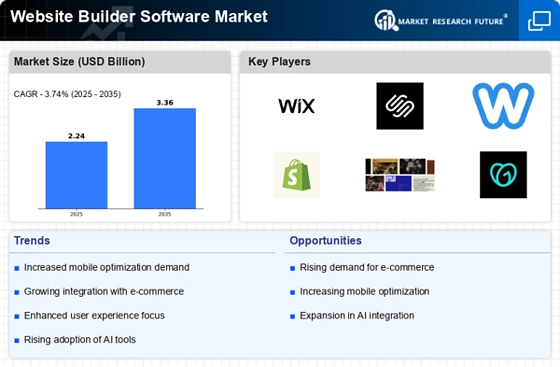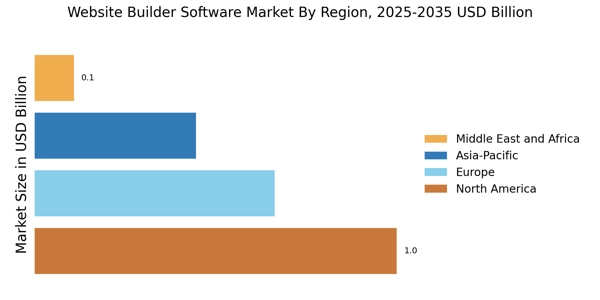Rising E-Commerce Adoption
The surge in e-commerce adoption is a pivotal driver for the Website Builder Software Market. As businesses increasingly transition to online platforms, the demand for user-friendly website builders has escalated. In 2025, e-commerce sales are projected to reach approximately 6 trillion USD, indicating a robust market for website builders that cater to online retailers. This trend compels website builder software providers to enhance their offerings, ensuring seamless integration with e-commerce functionalities. Consequently, the Website Builder Software Market is likely to witness significant growth as more entrepreneurs and established businesses seek to establish their online presence.
Increased Focus on Customization
The demand for customization in website design is a significant driver for the Website Builder Software Market. As businesses seek to differentiate themselves in a crowded marketplace, the ability to create unique and personalized websites becomes paramount. In 2025, it is anticipated that over 70% of consumers prefer brands that offer personalized experiences. This trend compels website builder software providers to enhance their customization features, allowing users to tailor their sites to reflect their brand identity. Consequently, the Website Builder Software Market is likely to experience growth as more users seek tools that enable them to create distinctive online presences.
Advancements in Artificial Intelligence
Advancements in artificial intelligence (AI) are transforming the Website Builder Software Market. AI technologies are being integrated into website builders to enhance user experience and streamline the design process. Features such as automated content generation, chatbots, and personalized recommendations are becoming commonplace. In 2025, it is estimated that AI-driven solutions will account for a substantial portion of the website builder market. This integration not only simplifies the website creation process but also improves functionality and user engagement. As a result, the Website Builder Software Market is likely to thrive as AI continues to evolve and shape user expectations.
Growing Importance of Digital Marketing
The growing emphasis on digital marketing strategies is a crucial driver for the Website Builder Software Market. Businesses recognize the necessity of having a strong online presence to attract and retain customers. In 2025, digital advertising spending is expected to surpass 500 billion USD, underscoring the need for effective website solutions that facilitate marketing efforts. Website builders that offer integrated SEO tools, analytics, and social media connectivity are becoming increasingly popular. This trend suggests that the Website Builder Software Market will continue to expand as companies strive to optimize their websites for better visibility and engagement.
Expansion of Small and Medium Enterprises (SMEs)
The expansion of small and medium enterprises (SMEs) is a vital driver for the Website Builder Software Market. As more entrepreneurs launch their businesses, the need for accessible and affordable website solutions becomes increasingly apparent. In 2025, SMEs are projected to account for over 90% of all businesses, highlighting the potential market for website builders tailored to this segment. These enterprises often require simple yet effective tools to establish their online presence without extensive technical knowledge. Thus, the Website Builder Software Market is poised for growth as it caters to the unique needs of SMEs.


















Leave a Comment